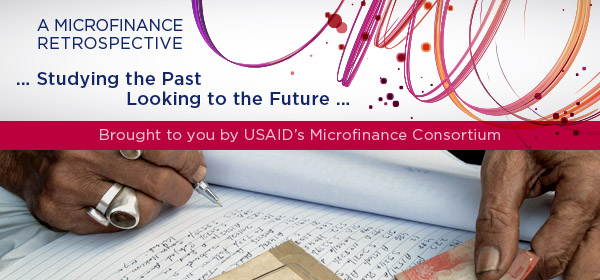Studying the Past, Looking to the Future: The Road that Microfinance Built

The Road that Microfinance Built
Forward
This blog series primarily highlights USAID’s contribution to the field of microfinance. And while USAID has been a major contributor, especially in terms of the commercialization of microfinance, we want to acknowledge that many other private and public sector actors also support microenterprises and microfinance, sometimes through long sustained efforts. Dr. Chao-Beroff’s work in rural Africa is an example of one those efforts. Her reflections on that work help us understand the impact of microfinance, not as a singular event or data point, but as a progression of changes.
In the 1980s, we were a bunch of economic development players who thought that entrepreneurial initiatives by poor people, if given the opportunity and the means, could radically change their lives. At the same time, we also thought such initiatives could change the economic paradigm, shifting it from top-down, government led development to a bottom up, people led economy. We wanted to support this dynamic as concretely as we could, from where we were.
It was a time of failures of development banks and commercial banks, which were not interested in poor people and their enterprises; so we started our own financial initiative to make up for this market failure—in Asia, Latin America, and sub-Saharan Africa almost at the same time. Those were pioneering days. We realized quickly that the mainstream conditions would not change anytime soon, so we wanted to move away from time bound projects into building sustainable institutions that would last long enough to accompany the growth of members/clients.
Then we spent the 1990s and part of the 2000s making these institutions grow, get strong systems, develop and streamline distribution channels, and become efficient and profitable. It became obvious in the course of time that there were two schools of thought: (1) those for whom the institutions were the most important because large and robust institutions were the only way to deliver at scale and meet the challenge of financial inclusion and (2) those for whom the clients would always be at the center.
In the early 2000s, consensus was reached at the industry level to aim at a double bottom line, where financial and social performance would be considered equally so as to address potential mission drift or, even more dramatically, unethical behaviors toward clients.
At that point, many lost their faith in microfinance as the solution to fight poverty, and they started moving away from the sector and from its debates. A few, to the contrary, thought that it was time to celebrate what microfinance had achieved, i.e., linking mainstream actors to the excluded and transforming this link into a mega opportunity of development for all. Those who held this perspective had already begun to explore the new connections that this link offers to billions of people and to work hard to make it a win-win business to all parties: the public, the private actors, and the people.
If we take a historical look at the decades of microfinance, it would look very much like this: an adventurous explorer discovers a new territory and then spends the rest of his life opening a wide road leading back to the rest of civilization. The discovery then opens the door to all kinds of exchanges between the territory, its people, and the old developed world. Despite the dangers, there is excitement and hope. There is also much disappointment and many tears; but at the end, the road would be there, and the two worlds would be connected.
For me, this is certainly the most important achievement of microfinance: opening a road that leads to the poor and the excluded. Now, not only do financial services travel down this road but so do all essential services, such as water, energy, education, health, and so much more. All of these services will be delivered efficiently to improve the lives of billions of people.
This type of effort exactly reflects my own life and experience. This includes my work in Mali in the 1980s with the Dogons—to build both community-owned and managed savings and credit associations (CVECAs) and access to assets and working capital for rural communities and microentrepreneurs—to my work today with PAMIGA (Participatory Microfinance Group for Africa), a network of rural microfinance institutions (MFIs), promoting green economy and green finance. This includes activities such as providing loans for productive water- and energy-related projects to enhance productivity for small farmers involved in value chains today. In one recent endeavor, through our partnership with Schneider-Electric, a large global industrial energy management group, PAMIGA’s value-added was clear: knowing the end-client at the “bottom of the pyramid” and having a network of MFIs who are already efficiently serving this market in a trustful, longstanding relationship.
Finally, in a discussion with women in rural Africa about their energy needs, it was so exciting to hear that they now prioritize access to fluid communications with family and friends living in local towns and abroad. In that discussion, one woman entrepreneur ranked cell phone charging even before developing her small business as a reason for wanting to get a loan for a solar home solution.
New needs, new (IT) solutions: for those who care about sustaining and empowering poor people, there are plenty of new opportunities that microfinance has helped us discover.

